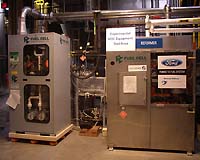 |
Pleasant Prairie WI (SPX) Oct 13, 2009 We Energies, Alstom and The Electric Power Research Institute (EPRI) jhas announced that a pilot project testing an advanced chilled ammonia process has demonstrated more than 90 percent capture of carbon dioxide (CO2) from the flue stream of at a coal-fueled power plant in Wisconsin. At a press conference at We Energies' Pleasant Prairie Power Plant, which hosted the project, We Energies Chairman, President and CEO Gale Klappa, Alstom U.S. President Pierre Gauthier, and EPRI Senior Vice President Hank Courtright discussed the demonstration of Alstom's patented chilled ammonia process for carbon capture. Testing at the pilot facility, using a 1.7-megawatt (electric) slipstream from the plant, began in early 2008 and will conclude later this year. The project confirmed the predicted performance of the chilled ammonia carbon capture system at an operating power plant. It achieved key research metrics around hours of operation, ammonia release, CO2 removal levels, and CO2 purity. In doing so, the project demonstrated the fundamental viability of the carbon capture technology in real-world conditions such as changes in temperature and humidity, the inevitable starts and stops of a large power plant, and the environmental hurdles that go along with using any chemical process. "One of the biggest challenges facing our industry is the development of cost effective technology that will allow us to capture carbon from the operation of power plants around the world," said Klappa. "Today, with the success we're reporting from the research here at Pleasant Prairie, the solution is one step closer to reality." Lessons learned at Pleasant Prairie already have provided critical information for efforts to scale up effective carbon capture and storage technologies for new power plants and for retrofit to existing plants. A scaled-up 20-megawatt (electric) capture system has been installed at AEP's 1,300-megawatt Mountaineer Plant, where it will remove an estimated 90% of carbon dioxide emissions from the flue gas stream it processes, capturing up to 100,000 metric tons of CO2 per year. The captured CO2 will be compressed, pipelined, and injected into two different saline reservoirs located approximately 8,000 feet beneath the plant site. Battelle Memorial Institute will serve as the consultant for AEP on geological storage as an extensive monitoring system will be used to track the extent of the sequestered CO2 over time. "This project has been a success. It proved what we needed to know to stay on schedule to commercialize carbon capture technology for new and existing power plants by 2015, a necessary step to meet ambitious climate change targets being proposed by policy makers in the U.S. and around the world," Gauthier said. "Alstom believes carbon capture, along with energy efficiency and a full portfolio of low carbon technologies including renewable power, will all be needed to achieve urgent CO2 reduction goals in a timely manner." Alstom, a leader in carbon capture technology, is pursuing 10 demonstration projects in six different countries, including the We Energies project and partnership at Mountaineer with American Electric Power. The Mountaineer project is one of two current or planned post-combustion carbon capture and storage (CCS) demonstrations for which EPRI has formed an industry collaborative to support management of testing and evaluations. The EPRI collaborative will support the integration process/design of CO2 capture technologies and the monitoring and verification of CO2 storage, and it will assess the large-scale impacts of CO2 controls and storage on post-combustion coal-fueled generation. The data collected and analyzed by the collaborative will support efforts to advance CCS technologies to commercial scale and provide information to the public and industry on future electricity generation options. EPRI is leading or supporting seven Industry Technology Demonstrations as part of its efforts to help develop a "full portfolio" of innovative technology approaches needed to make substantial CO2 emissions reductions while minimizing economic impacts. EPRI's Prism and MERGE analyses (available at www.epri.com) found that deployment of a full portfolio of advanced technologies, including CCS, could reduce U.S. electric sector CO2 emissions by 2030 to a level below 1990 emissions. EPRI currently is working on a global analysis that is expected to show similar energy mix changes and significant economic impacts. "We Energies, Alstom, EPRI and 37 other companies worked together to successfully advance carbon capture technology to the next step in its development," said EPRI Senior Vice President Hank Courtright. "EPRI's analyses show carbon capture and storage will be essential to achieve meaningful CO2 emissions reductions, and do it in a cost-effective way while meeting demand growth. Projects like this one, where a company steps up to lead a project and several more form a collaborative support it, are critical to advancing the technologies that we need to reduce the industry's carbon footprint." Share This Article With Planet Earth
Related Links Pleasant Prairie carbon capture project We Energies Powering The World in the 21st Century at Energy-Daily.com
 New Material Could Improve Solid Oxide Fuel Cells
New Material Could Improve Solid Oxide Fuel CellsAtlanta GA (SPX) Oct 08, 2009 A new ceramic material described in the journal Science could help expand the applications for solid oxide fuel cells - devices that generate electricity directly from a wide range of liquid or gaseous fuels without the need to separate hydrogen. Though the long-term durability of the new mixed ion conductor material must still be proven, its development could address two of the most ... read more |
|
| The content herein, unless otherwise known to be public domain, are Copyright 1995-2009 - SpaceDaily. AFP and UPI Wire Stories are copyright Agence France-Presse and United Press International. ESA Portal Reports are copyright European Space Agency. All NASA sourced material is public domain. Additional copyrights may apply in whole or part to other bona fide parties. Advertising does not imply endorsement,agreement or approval of any opinions, statements or information provided by SpaceDaily on any Web page published or hosted by SpaceDaily. Privacy Statement |